Star Types
Variable, RR Lyrae & Cepheid Variable Stars




You Should Know
reference information for variable stars
Ψ Variable Star - is a star who's apparent brightness as seen from Earth changes over time. This is so even if the changes are due to variations in the star's actual luminosity, or to variations in the amount of the star's light that is blocked from reaching Earth. Many, possibly most, stars have at least some variation in luminosity: the energy output of our Sun, for example, varies by about 0.1% over an 11 year solar cycle. See Wikipedia
Ψ Cepheid or Cepheid Variable - is a particular class of stars within the Variable Star category. In 1904, Henrietta Leavitt, an astronomer at the Harvard Observatory, discovered a strong link between the period of variability and absolute luminosity within a group of stars later called Cepheids. This type of star can be used as a standard candle to determine the distance to its host cluster or galaxy. Since the period-luminosity relation can be calibrated with great precision using the nearest Cepheid stars, the distances found with this method are among the most accurate available. In 1923, Edwin Hubble used the star Delta Cephei (this star is the prototype Cepheid variable) to show that the Andromeda Galaxy was located outside the Milky Way. See Windows to the Universe at The University Corporation for Atmospheric Research. and Observing Delta Cephei from The American Association of Variable Star Observers
Ψ RR Lyrae Variable Star - is the brightest member within the class of variable stars. They are similar to Cepheids but are less luminous and have a shorter period of variability, usually 5 hours to just over a day. Much like the Cepheid, once you know that a star is an RR Lyrae variable (eg. from the shape of its light curve), then you know its luminosity. However, RR Lyrae stars are old, relatively low mass stars that are less luminous than Cepheids but are the more common of the two.
Ψ Beat Chepheid - is a classical Cepheid variable star pulsating in two radial modes simultaneously. They are sometimes refered to as double-mode Cepheids.
Ψ John Goodricke (1764-1786)  was a very young astronomical researcher and a deaf mute who made many of the discoveries that established variable stars as an important topic for research. His most famous discovery is the variable star known as Delta Cephei, the prototype Cepheid variable.
was a very young astronomical researcher and a deaf mute who made many of the discoveries that established variable stars as an important topic for research. His most famous discovery is the variable star known as Delta Cephei, the prototype Cepheid variable.
Ψ Henrietta Swan Leavitt  was born in Lancaster, Massachusetts, and graduated from Radcliffe College in 1892. In 1902 she became a permanent staff member of the Harvard College Observatory (HCO) and through her scientific ability quickly rose to head the department of photographic stellar photometry.
was born in Lancaster, Massachusetts, and graduated from Radcliffe College in 1892. In 1902 she became a permanent staff member of the Harvard College Observatory (HCO) and through her scientific ability quickly rose to head the department of photographic stellar photometry.
During her tenure at Harvard, she spent a great deal of time searching photographic plates of the night sky searching for variable stars in both the Large Magellanic Clouds (LMC) and Small Magellanic Clouds (SMC). In 1904, using a rather laborious process called superposition, she discovered 152 variable stars in the LMC and 59 in the SMC. Over the next year she reported 843 new variables in the SMC. These discoveries led Charles Young of Princeton to remark in a letter to HCO director E. C. Pickering, "What a variable-star 'fiend' Miss Leavitt is, one can't keep up with the roll of the new discoveries."
Probably Leavitt's greatest discovery came from her study of 1,777 variable stars in the Magellanic Clouds. She was able to determine the periods of 25 Cepheid variables in the SMC and in 1912 she announced what has since become known as the famous Period-Luminosity relation, "A straight line can be readily drawn among each of the two series of points corresponding to maxima and minima, thus showing that there is a simple relation between the brightness of the variable and their periods." Henrietta Leavitt passed away from cancer in 1921. See Michael Scharmack Our little Part of the Universe website.
Ψ Delta Cephei - to astronomers, this is one of the most famous stars in the sky. It is visible to the naked eye, has a short period of variation ( 5 days, 8 hours & 37.5 minutes ) and is an easy find in the sky due to its position. It's spectral type varies between F5 and G2. One of the single most important tools in calculating astronomical distances is the use of Cepheid Stars in order to verify the precision of astronomical calculations, "agreement between these two independent, geometrical calibrations is remarkable and greatly increases the confidence in the cosmic distance scale now in use." See Refining the universe's size article by Michael E. Bakich, 2004 Astronomy.com news archive.
Cepheids & RR Lyrae
calibrating distance with a variable class of stars
When astronomers measure the distance to our moon, a planet or other object in our solar system, the data they obtain is very accurate. This is a result of the tools and technologies employed: radio, radar and laser. However, the limitations of this technology is that our solar system is the furthest extant to which they are capable of being utilized. Thereafter, the distance to the closest galaxies and stars to us are much too far, even for instruments that send out signals at the speed of light. So, how do we obtain accurate measurments of distant objects? How can we be sure that our instruments are precise and accurate over the millions of light years which we must measure? Enter the Cepheid Variable Star...
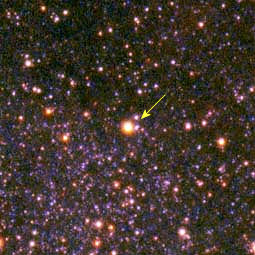 Delta Cephei - The Prototype Cepheid
Delta Cephei - The Prototype Cepheid
Delta Cephei is a Cepheid star and one in a class of variable stars that astronomers use in measuring distances to nearby galaxies. Cepheid variables, as they are also called, expand and contract causing the amount of luminosity they generate to brighten and dim. This expansion and contractioin is caused by gravity which exterts pressure towards the star's core and by the ionization of gas (helium) and radiation, which wants to expand the star. For the Cepheid, the measured period of time from expansion to contraction is related to the star's luminosity. Remembering our introductory dicussions in the beginning sections of "Stars" regarding apparent magnitude and luminosity, we need only to add the function of time to our data and we can begin to calculate distance:
Distance Calculating, The Two Formulas
There are several ways [ fn.1 ] of determing the distant to Cepheid Stars:
[I]
First we measure the Cepheid's period of variation ( bright to dim ) and based on this result we are able to judge the star's absolute magnitude. Next we measure the star's apparent magnitude ( it's brightness as seen from earth ) and with this information we use a formula called the "Distance Modulus",
mv — Ma = 5log10 (d) — 5
 In the early 1900's Henrietta Leavitt showed that a relationship existed between the period of a Cepheid's cycle and luminosity or what is known as the Period-Luminosity relation. When data from a pair of Cepheid's, with the same period of variance, is converted by using the Distance Modulus, the one with the greater average magnitude is the star that is nearest to us. RR Lyrae stars are a sub-classification of Cepheid variables but they too are used as a distance benchmark in the same way.
In the early 1900's Henrietta Leavitt showed that a relationship existed between the period of a Cepheid's cycle and luminosity or what is known as the Period-Luminosity relation. When data from a pair of Cepheid's, with the same period of variance, is converted by using the Distance Modulus, the one with the greater average magnitude is the star that is nearest to us. RR Lyrae stars are a sub-classification of Cepheid variables but they too are used as a distance benchmark in the same way.
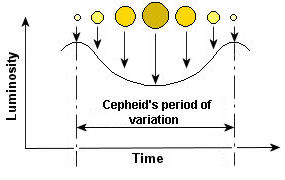 Leavitt's Period-Luminosity relation
Leavitt's Period-Luminosity relation
[II]
Another formula for determing the distance to Cepheids is to use the inverse-square law. At Hands-On Astrophysics (HOA), variable stars are what it's all about. This educational web site provides the student (and educator) with software, lessons and more in order to "...give them the necessary information and skills to study variable star behavior or to become amateur variable star observers." HOA is an AAVSO educational project developed with funds from the National Science Foundation.
In their manual, HOA outlines the following steps required for calculating distances to Cepheids:
1. Identify the star as a Cepheid variable by studying its spectrum (if possible) and/or by the shape of its lightcurve.
2. Calculate its period.
3. Use the Period-Luminosity relationship to determine the absolute magnitude.
4. Use the inverse-square law to calculate how far a star of that absolute magnitude would have to be moved from the standard distance of 32.6 light-years to appear as a star of the apparent magnitude observed.
Which method you use depends on the data you have: if you have luminosity and fluxes (apparent brightness) you use the inverse-square law and if you have magnitudes you use the distance modulus. A complete description of both formulas and lab can be found at the University of Michigan's Astronomy Department, Cepheids and the Extra-Galactic Distance Scale
[ fn 1 ]
Another way of measuring and calibrating Cepheids is called long-baseline interferometry employing the Baade-Wesselink interferometric method and using "...two beams - one set from the two VLTI Test Siderostats with 0.35m aperture and the other set from two Unit Telescopes (Antu and Melipal; 8.2m mirrors) - with the VINCI (VLT Interferometer Commissioning Instrument) facility." ESO
References -- Additional Infromation
Apollo Laser Ranging Experiments Yield Results "Scientists who analyze data from the Lunar Laser Ranging Experiment have reported some watershed results..."
Radar Astronomy "...application of radar to the determination of distances" Columbia Encyclopedia
Radar Astronomy at Wikipedia"...technique of observing nearby astronomical objects by reflecting microwaves off target objects and analyzing the echoes."
Radio Telescopes' Sharp Vision Yields Rich Payoffs "Using radio telescopes, we are measuring distances and motions of celestial bodies with unprecedented accuracy." Press release from the HARVARD-SMITHSONIAN CENTER FOR ASTROPHYSICS.
Age & Distance
Recalibrating the stellar Yardstick
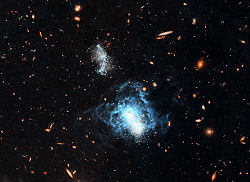 Galaxy I Zwicky 18
Galaxy I Zwicky 18
"...measuring distances and motions of celestial bodies with unprecedented accuracy." In science that's what it is all about, accuracy, pure and simple. The problem is that when we look out from earth, at any given stellar object in the universe, we are trying to view something over distances so great that even the smallest error factor can cause huge inaccuracies. This is similar to being a half to one degree off in navigating a route over a long distance—you usually find yourself miles away from where you intended to be. The difference is that here on Earth we're talking in terms of miles; when it comes to exploring the universe, we're talking Light Years!
"The Cepheid stars have taken on an even more important role since the Hubble Space Telescope Key Project on the extragalactic distance scale relies completely on them for the calibration of distance indicators to reach cosmologically large distances. In other words, if the calibration of the Cepheid Period-Luminosity relation were wrong, the entire extragalactic distance scale and with it, the rate of cosmic expansion and the related acceleration, as well as the estimated age of the Universe, would also be off." [ see Measuring Cosmic Distances with Stellar Heart Beats ]
Off in the Distance
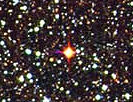 Proxima Centauri APOD
Proxima Centauri APOD
The distances involved in the science of astronomy are so vast that conventional units of measurement, like miles, are simply unwieldy. Instead, astronomers employ larger units that are either based on a standard calculation of time x velocity, Light Year [ ly ] or on a fixed unit of distance, Parsec [ pc ]. When measuring objects within our solar system astronomers typically use the Astronomical Unit [AU] which is equal to the distant between the Earth and the Sun or about 93 million miles. However, once we proceed beyond the boundaries of our solar system and surrounding areas, the units for relating distance are the Light Year, equal to 186,000mps x 60sec x 60min x 24hrs x 365.25days = 5,869,713,600,000 miles and the Parsec, approximately 3.121 light years ( 18,319,376,145,600 miles ). With this in mind consider all the following:
Ψ The nearest star to us is Proxima Centauri at 4.2 light years ( 24,652,797,120,000 miles ).
Ψ Stars within our galaxy are very far apart, averaging about 8 lightyears ( 46,957,708,800,000 miles ) for the closest dozen stars to us.
Ψ The distance from our Sun to the center of our galaxy is 30,000 light years ( 176,091,408,000,000,000 miles ).
Ψ The diameter of our galaxy is 100,000 light years ( 586,971,360,000,000,000 miles ).
Ψ The distance to the nearest two galaxies is 70,000 light years for the Sagittarius Dwarf Elliptical Galaxy and about 2.7 million light years ( 15,848,226,720,000,000,000 miles ) for the Andromeda galaxy.
Ψ In 1999 NASA estimated the number of galaxies at approximately 125 billion, noting a high probability that up to twice that number exist; some current estimates for the number of galaxies in the visible universe are around 350 billion.
Ψ The current approximate size for our universe is 13-15 billion light years ( 7.63062768e22 miles ).
"One of the most important breakthroughs in astronomy was the development of accurate distance determination methods for the nearby stars. Distances in astronomy are elusive, and astronomers use many methods to determine them. Our knowledge of the size and scale of the Universe is based upon some fundamental distances, and the distances to the nearby stars are one pillar upon which many theories rest. How certain are we about the distance to a nearby star?" Hayden Planetarium, Digital Universe
Recent scientific surveys of Cepheid stars have been aimed at increasing the accuracy of their use as a calibrating tool. One result of this is that the Hubble Constant has also seen revision.
 NGC 4258 in visible, infrared, x-ray and radio bands APOD
NGC 4258 in visible, infrared, x-ray and radio bands APOD
"A portion of the nearby galaxy NGC4258 was observed to look for Cepheid variable stars using the WFPC2 camera and the Hubble Space Telescope on 11 epochs in 1998. It was possible to identify and determine light curves, periods, mean magnitudes and colours for 15 Cepheids. The distance calculated from the Cepheids was 8.1 plus or minus 0.4 Mpc. Revising Cepheid-calibrated distance indicators on the basis of the maser distance would boost the measured Hubble constant by 12% plus or minus 9%, with the corresponding age of the Universe falling similarly." See Article Abstract from the Internet FAQ Archives
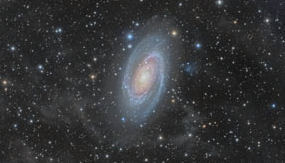 BODE'S GALAXY M 81, Credit & Copyright Jordi Gallego
BODE'S GALAXY M 81, Credit & Copyright Jordi Gallego
Another project, using the Hubble Space Telescope, was the Key project which published it's findings in 2001. The scientific team "made 22 twenty-minute exposures of each of two fields in M 81 containing the Cepheids. Once the data from these was reduced they were able to calculate a distance to M 81 of 3.4 megaparsecs (about 11 million light years) compared to the previous range of values of 1.3 to 5.6 megaparsecs." The final result "...gave a value of H0 = 72+/-8 km s-1 Mpc-1." Which is the value we currently use for the Hubble Constant.
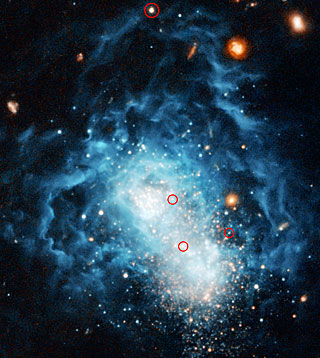 The Cepheids of Galaxy I Zwicky 18 NASA, ESA, and A. Aloisi
The Cepheids of Galaxy I Zwicky 18 NASA, ESA, and A. Aloisi
One good example of using Cepheids as both an age and distance tool is I Zwicky 18, a dwarf irregular galaxy that is smaller than our Milky Way. Hubble survey results have indicated that this galaxy is older than previously thought, "Hubble has now found faint, older stars within this galaxy, suggesting that the galaxy may have formed at the same time as most other galaxies." The image survey gave astronomers a first time chance to view Cepheids in I Zwicky 18 ( red circles in above image ) and this led to the determination that this galaxy is 59-million light years from Earth which is 10-million light years more than previously calculated -- a difference of 58,697,136,000,000,000,000 miles!
References -- Additional Infromation
» Measuring Cosmic Distances with Stellar Heart Beats
VLTI Watches the Changing Size of Bright Southern Cepheids.
» Astronomy 162 Stars, Galaxies, and Cosmology Dept. of Physics, University of Tennessee
» Cosmic distance ladder from Wikipedia
» Younger stars and an older, bigger cosmos Science News article, 1997 in .pdf format
» ESA's Hipparcos satellite revises the scale of the cosmos 1997 article from the European Space Agency.
» Is the Universe Younger than its Oldest Stars? Tim Thompson, physicist, JPL
» Searching for Long-period Cepheids in NGC 4258 with Gemini for the extragalactic distance scale.
The Cepheids
a different type, a different purpose
 M33: Triangulum Galaxy Credit & Copyright Paul Mortfield
M33: Triangulum Galaxy Credit & Copyright Paul Mortfield
Another variable type that is being used in survey projects is the Beat Cepheid. In The Astrophysical Journal, 653: L101—L104, 2006 December 20,
entitled "DETECTION OF BEAT CEPHEIDS IN M33 AND THEIR USE AS A PROBE OF THE M33 METALLICITY DISTRIBUTION"
"The determination of the abundance distributions provides an important constraint for evolution models of galaxies. These abundances, which are traditionally obtained through spectroscopic means, although other approaches have also been developed, are beset with large uncertainties. In this Letter we discuss a totally independent determination of the galactic metallicity (Z) distribution with the help of beat Cepheids (BCs) that promises to have a good accuracy." Reference Abstract: BEAT CEPHEIDS IN M33 .pdf format.
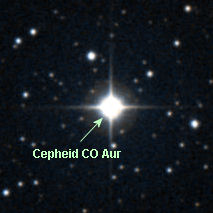 Beat Cepheid CO Aur, The Aladin SkyAtlas
Beat Cepheid CO Aur, The Aladin SkyAtlas
The project authors concluded that Beat Cepheids "...can...provide an additional, independent probe of galactic metallicity distributions." As of 2004 there were 22 beat Cepheids known in the Milky Way with one uncertain [ reference source: Beat Cepheids, a galactic table of information on these stars. ]
Cepheids are also used in determining star formation history, "Cepheid variables can be used for more than just a distance indicator. Since the age can be determined from the period, they can be used to trace the star formation history of a galaxy." [ see Cepheids as tracers of star formation in M31 ASTRONOMY & ASTROPHYSICS DECEMBER II 1997, PAGE 401 SUPPLEMENT SERIES. Downloadable in .pdf format ] This is another important use of the Cepheid variable star, the method of which is described in the abstract:
"Another important use of Cepheids is due to the fact that their ages can be determined from the pulsation period. The Cepheid variability occurs when the star passes through the instability strip, after the star has evolved away from the main sequence. The mass of the star determines the period of the variability, and the mass is also directly related to the main-sequence lifetime of the star. Therefore, the age of the star can be determined from the period of the oscillation." [ Ibid ]
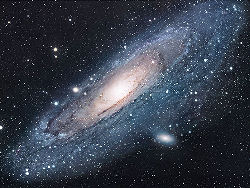 M31: The Andromeda Galaxy APOD & © Robert Gendler
M31: The Andromeda Galaxy APOD & © Robert Gendler
The survey group [ E.A. Magnier et al. ] concluded, "We have searched for Cepheid variables in portions of M 31 which have previously been ignored. We have found 130 new Cepheid variable candidates...These Cepheids will be used to study the star formation history in M 31."
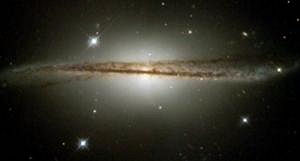 ESO 510-G13 Deriving The Shape Of The Galactic Stellar Disc
ESO 510-G13 Deriving The Shape Of The Galactic Stellar Disc
Though an advanced field of study beyond the scope of this page, Cepheids are also used in the research field for galactic abundance gradients. The theoretical argument was started around 1958 by Van den Bergh that a metallicity gradient should exist in the galactic disc ( the plane in which the spirals, bars and discs of disc galaxies exist. Galaxy discs tend to have more gas and dust, and younger stars than galactic bulges, or galactic haloes. ) "In recent years the problem of radial abundance gradients in spiral galaxies has emerged as a central problem in the field of galactic chemodynamics." [ see: Using Cepheids to determine the galactic abundance gradient & The galactic abundance gradient from Cepheids ]
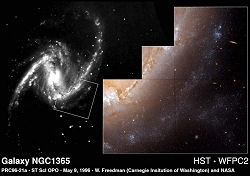 NGC 1365 Zooming In Hubble Site
NGC 1365 Zooming In Hubble Site
Finally, Cepheids have been the benchmark for the age of the universe as well as it's rate of expansion, "Astronomers used Cepheid variable stars in Fornax to estimate the cluster's distance from Earth, about 60 million light-years. Cepheids are bright, young stars that are used as milepost markers to calculate distances to nearby galaxies. Galaxy distances are important in calculating the universe's expansion rate and age." [ Hubble Space Telescope on Track for Measuring the Expansion Rate of the Universe ]
References -- Additional Infromation
» Infrared Surveys: Some prospects for galactic structure studies using cepheids and other young objects
» Variable Stars at Wikipedia Information on history, discovery and types
Zeroing in on the Cepheid Calibration
Images & Graphs from the European Organisation for Astronomical Research in the Southern Hemisphere
In October of 2004 the ESO issued a press release regarding the survey of Cepheids stars in the Southern Hemisphere. They summurized the survey and findings as follows:
"Taking advantage of the very high spatial resolution provided by the Very Large Telescope Interferometer, a team of French and Swiss astronomers has measured directly the change in angular diameter of four southern Cepheid variable stars over their pulsation cycle. When combined with spectroscopic radial velocity measurements, this allowed the astronomers to measure very accurately the distances of these stars in a quasi-geometrical way, and to calibrate the zero-point of the Cepheid Period-Luminosity empirical law. These observations constitute a fundamental step towards an independent verification of the extragalactic distance scale by interferometry." footnote omitted
Below are images and information from the Simabd & Aladin Skyatlas websites on four of the seven Cepheids used in this survey.
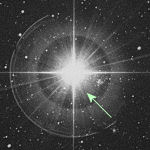
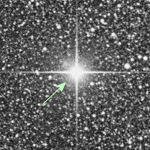
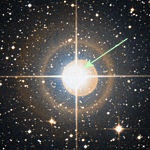

[1] Cepheid Variable Beta Dor, listed as a Classical Cepheid (delta Cep type) with a spectral classification of F6Ia and Located at RA 05 33 37.5177 and Dec. -62 29 23.371
[2] Cepheid Variable W Sgr, listed as a Classical Cepheid (delta Cep type) with a spectral classification of F7.2Ib and Located at RA 18 05 01.2252 and Dec. -29 34 48.315
[3] Cepheids Variable Eta Aql, listed as a Classical Cepheid (delta Cep type) with a spectral classification of F6Iab and Located at RA 19 52 28.3679 and Dec. +01 00 20.378
[4] Cepheid Variable Y Ophiocus, listed as a Classical Cepheid (delta Cep type) with a spectral classification of F8Iab and located as RA 17 52 38.7034 and Dec. -06 08 36.879
The following images and information are from the relevent ESO website page.
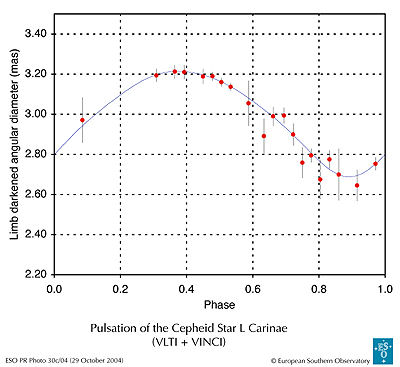
VINCI observations of the pulsation of the Cepheid variable L Car (P = 35.5 days, red dots) and the adjusted radius curve (green line), as deduced from the integration of the radial velocity measured on this star over its pulsation period. ESO Website VLTI Watches the Changing Size of Bright Southern Cepheids
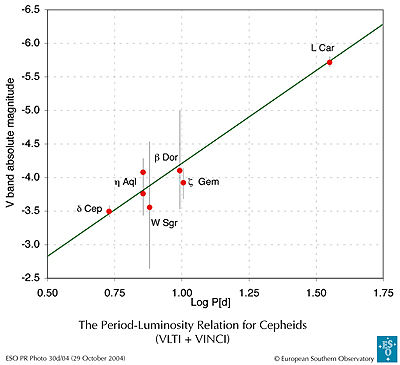
The Period-Luminosity relation in the V band, as deduced from the interferometric observations of Cepheids and the HST parallax measurement of Delta Cep. The green line is the fitted P-L relation, assuming the slope from previous authors (Gieren et al.; 1998, ApJ, 496, 17). The agreement between the model and the measurements is excellent, in particular for the high-precision measurements of Delta Cep and L Car. Ibid
The efforts by the team of French and Swiss astronomers [ 1 ] were successful:
"Combining the distances measured by this programme with the apparent magnitudes of the stars, the astronomers determined the absolute magnitude (intrinsic brightness) of these stars and arrived at a very precise calibration of the zero-point of the Period-Luminosity relation (assuming the slope from previous work).
It turned out that this new and independently derived value of the zero-point is exactly the same as the one obtained during previous work based on a large number of relatively low-precision Cepheid distance measurements by the ESA Hipparcos astrometric satellite. The agreement between these two independent, geometrical calibrations is remarkable and greatly increases the confidence in the cosmic distance scale now in use."
[1] - The team consists of Pierre Kervella and Vincent Coudé du Foresto at the Paris Observatory in France, David Bersier of the Space Telescope Science Institute (USA), Nicolas Nardetto and Denis Mourard (Observatoire de la Côte d'Azur, France), and Pascal Fouqué (Observatoire Midi-Pyré né es, France).
Cepheids
Additional Information & Resources
Ψ Cepheids in the Nainital Microlensing Survey
Photometric light curves for a classical Cepheid in RI bands monitored during Nainital Microlensing Survey.
Ψ THE SBF SURVEY OF GALAXY DISTANCES
Using Cepheids as a comparative tool in the testing of another method which measures surface brightness fluctuation (SBF) to determine galaxy distances.
Ψ Stellar Catalogs -- Galactic Cepheids near the celestial equator This page lists a number of stellar catalogs which might be useful for reduction of TASS images. NOTE: The TASS home page has moved very slightly. I'm not sure yet what my machine's name will be, but the IP address is definite, so the URL below uses the IP address http://129.21.188.4/tass/tass.shtml. Special thanks to The All Sky Survey website and it's links page which I've often used when searching information for this site.
Ψ The RR Lyrae Distance to the Draco Dwarf Spheroidal Galaxy A. Z. Bonanos, K. Z. Stanek, A.H. Szentgyorgyi, D.D. Sasselov, G.A. Bakos, first CCD variability study of the Draco dwarf spheroidal galaxy [ arXiv:astro-ph/0310477v2 ].
Ψ Pulsating Stars Enable New Precise Determination Of Rotation Of The Milky Way Science Daily article: "New, very precise measurements have shown that the rotation of the Milky Way is simpler than previously thought. A remarkable result from the most successful ESO instrument HARPS, shows that a much debated, apparent 'fall' of neighbourhood Cepheid stars towards our Sun stems from an intrinsic property of the Cepheids themselves."
Quick Nav
Where to Go
This Page
VARIABLE STARS
Next Page
Neutron Stars
Under Construction
Back to The
Star Page Main
Back to The
Main Page
This Page -
Variable Stars
Next Page -
Neutron Stars
Under Construction
Back To -
Main Star Page
Back To -
Main Index Page

Astronomy Education from the University of Nebraska-Lincoln. A variable Star Photometry Analyzer simulation, nice!
Binary Stars
Brown Dwarf
White Dwarf
Red giant
Variable Stars
Neutron/Pulsar Star
All the below under construction
Supergiants
Quasars